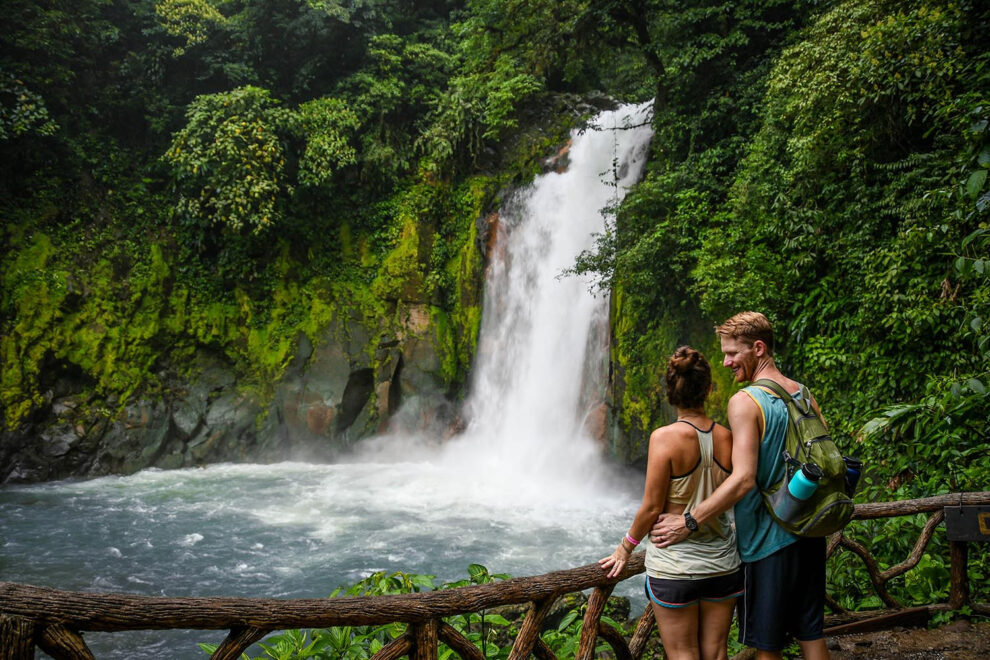Blessed with staggering tropical forests that roll down to equally stunning coastlines, it’s no wonder Pura Vida—the Costa Rican catchphrase for appreciation, relaxation, and blissed-out simplicity—is the word on repeat here.
For Costa Ricans or Ticos, it means enjoying life no matter what: Start with the fact that Costa Rica covers only 0.03 percent of the surface of the globe, yet lays claim to more than 5 percent of its entire existing biodiversity. This pans out to an extraordinary abundance of plant and animal species, rivers and waterfalls, forests (there are six here), and gobsmacking coastlines. Pura Vida, indeed.
Naturally, active adventures lead this list on the best things to do in Costa Rica, but there’s more in terms of sheer beauty (when you go, please be on a mission to spot the resplendent quetzal bird) and unique culture (don’t miss Caribbean outposts, like Puerto Viejo).
Here are eight of the best things to do in Costa Rica.
1. Explore a rainforest
Costa Rica is home to six different kinds of rainforest, with nearly 25 percent of the entire country consisting of untouched primary rainforest. These ecosystems are an extraordinarily diverse array of flora and fauna, including howler and spider monkeys, sloths, multiple species of toucans and macaws, and thousands of species of trees.
Amazing parks pepper the entire country, but set your sights on the west coast and Manuel Antonio National Park with its lovely beaches, or northwest of San José for Arenal Volcano National Park, where visitors can also take in the park’s namesake dormant volcano and natural hot springs. Corcovado National Park, far to the southern edge of the country on the remote Osa Peninsula, is the largest park in Costa Rica at 164 square miles. It’s packed with stunning rainforests, lagoons, mangrove swamps, and rivers. It’s also home to tapirs, jaguars, and scarlet macaws—which you may see flying in pairs.
Tip: Take your time as you explore, look up and around often, and hire a guide. Every layer of the forest is so ridiculously dense, and without a trained eye pointing out its marvelously disguised creatures, you’re sure to miss so much of the beauty of this environment. Even better, make a point of going during the green season (from May through November) to experience a rain shower in a Costa Rican rainforest.
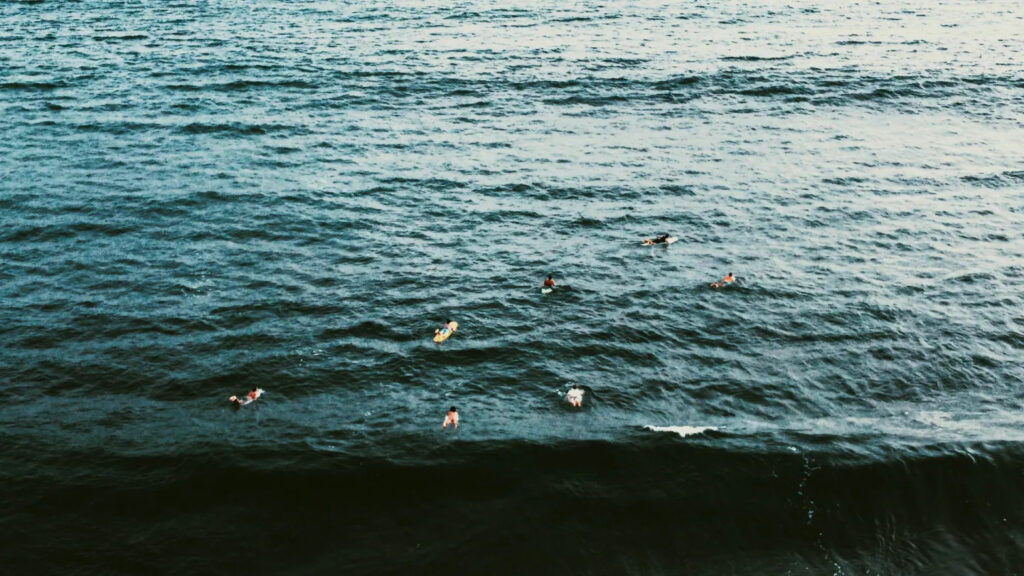
2. Surf the Pacific coast
Costa Rica’s consistent year-round swell and pleasant water temperatures (you won’t need a wet suit) have made it one of the world’s best destinations for surfing.
The most famous is located along Costa Rica’s southern Pacific coast in Pavones, where surfers can catch the longest left-hand wave in the world—up to a half-mile long—for a ride that can last up to two minutes. For advanced waves, get a pulse from locals on swell conditions at Roca Bruja, where right- and left-hand waves, and the chance to ride a chute, are the draw. More consistent waves can be had at Jacó Beach, also a popular surf spot with locals and partygoers.
Surf camps abound in nearly as many spots. Pair an itinerary of expertly run surf lessons with an uber comfortable stay, yoga, and massage at Kalon Surf Resort. The resort is situated near Playa Linda, a mostly undeveloped but clear sandy beach with blue waters and palm trees. This is a place for everyone, with both long whitewater for beginners and big swells for big riders, plus a gentle beach break. Dolphins and whales make appearances here, too.
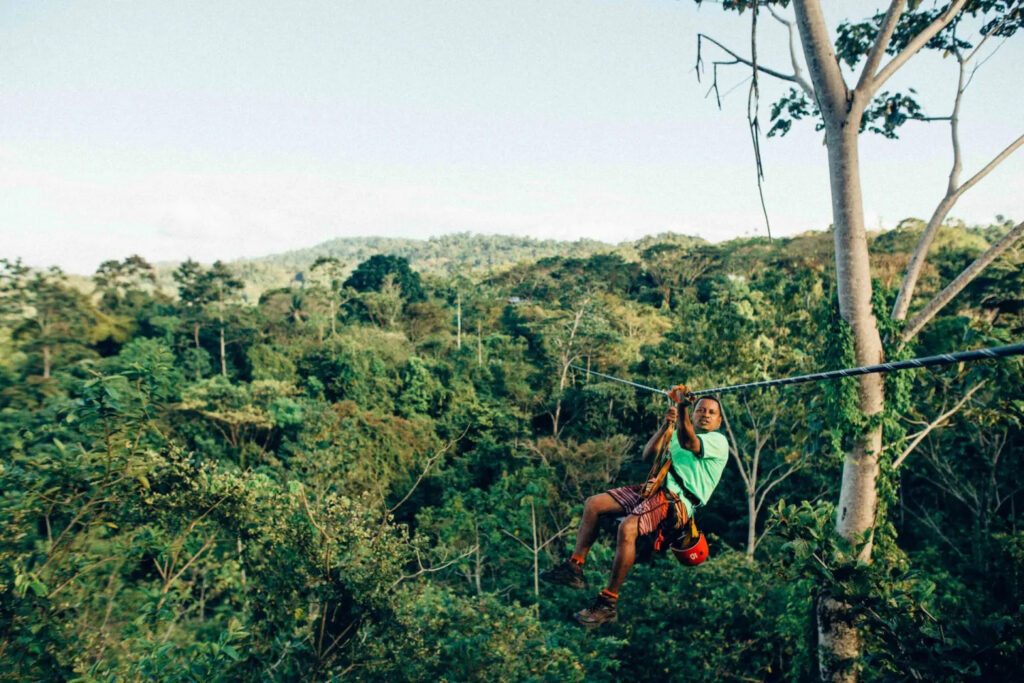
3. Zipline across thrilling skies
Modern ziplining originated in Costa Rica in the 1970s by a wildlife biologist in search of a better way to explore the forest. Fast forward to now and this eco-tour adventure abounds all over the world, though Costa Rica easily remains one of the most exceptional places to zipline.
Want an especially thrilling ride? Try the Monteverde Cloud Forest Reserve, a place revered for its conservation efforts and birthplace of that very first recreational zipline. The high-altitude forests here are dramatic thanks to clouds and mist, all through which can be experienced by dropping (no kidding) into the canopies of towering trees and Tarzan-like vines and mosses. It’s also home to the elusive resplendent quetzal, a shimmery green and red bird that’s among the rarest to spot and found only in cloud forests habitats. While there, set out for a jaunt on Costa Rica’s hanging bridges, which offers another unique way to access and experience the upper layers of its magical forests.
Return to intimate Senda Monteverde for modern mountain bungalows set in these same cloud forests, 15 minutes from the town of Monteverde. Part of Cayuga Collection’s sustainable luxury hotels, the hotel’s energy efficient design with solar-heated water, an entirely local staff, and an organic locally sourced menu are just the start of an impressive green model. Stays here also include complimentary access to neighboring Aguti Wildlife Reserve—take a guided nighttime hike to see an entirely different side of the forest, including nocturnal frogs, owls, and fascinating insects.
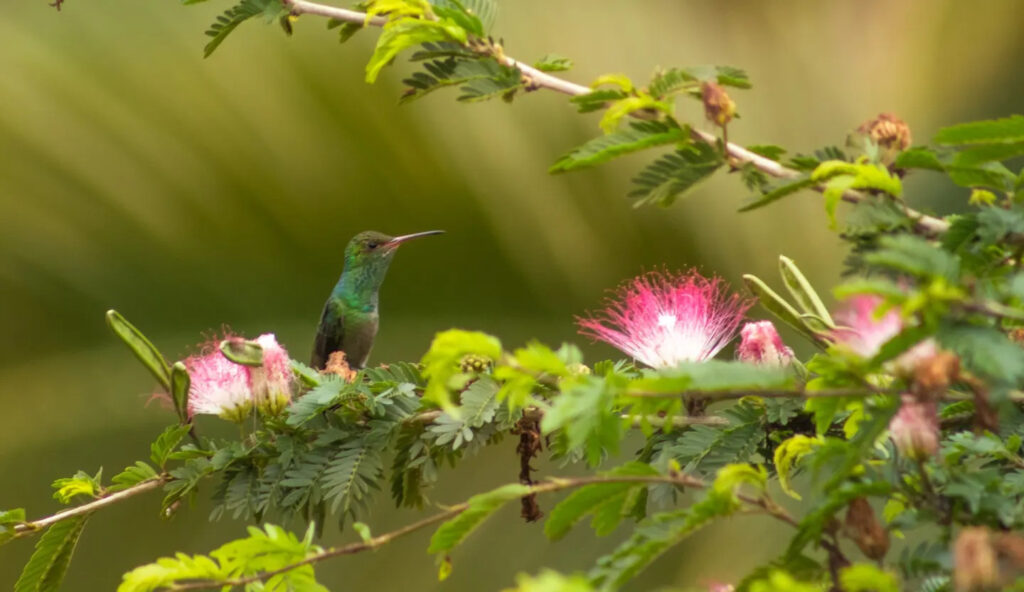
4. Birdwatch like there’s no tomorrow
Big-deal wildlife sightings in Costa Rica often overshadow the 850 different species of birds found here. The sightings here are so spectacular they’ll quickly convert non-birders to the club. In addition to the quetzal, look for pairs of scarlet macaws flying over the Osa Peninsula. Prolific numbers of migratory birds travel during the rainy fall season at Palo Verde National Park, when the Tempisque River floods create a broad marsh area. Aquatic bird-watchers: look for the Jaribu, tiger heron, and white ibis. At Carara National Park, spot the laughing falcon, yellow-naped parrot, and dazzling rufous-tailed jacamar. Heck, even the treetops at your hotel pool are great spots for toucans, macaws, and more.
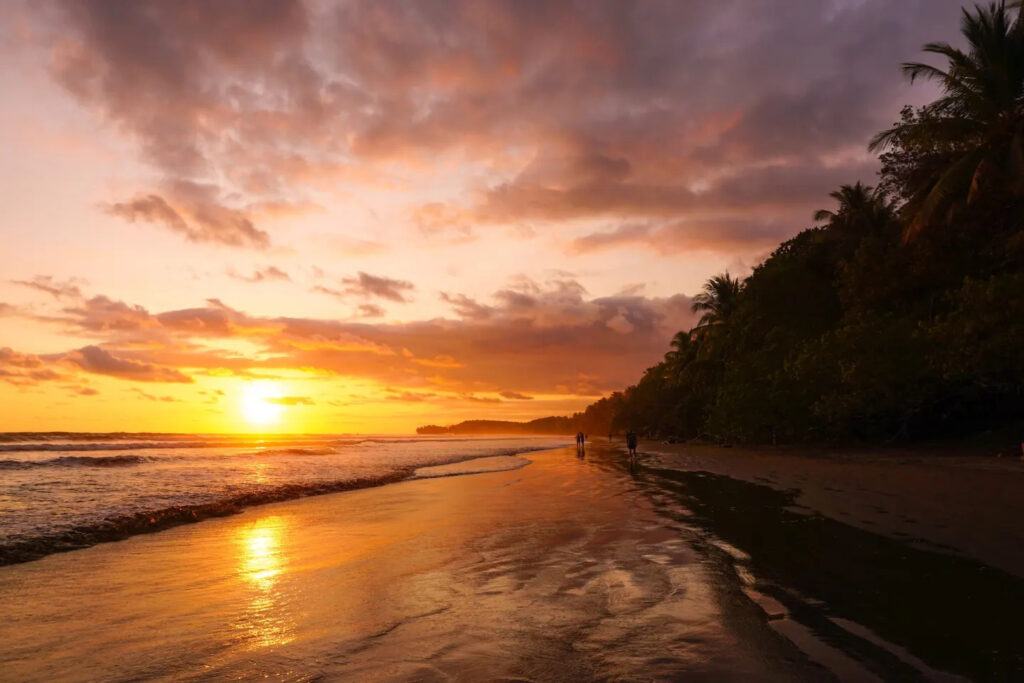
5. Hit the beach
Visiting a beach is unquestionably one of the best things to do in Costa Rica. Travelers can find palm trees for shade along the north Pacific coast, wild jungles going right up to the water along the south Pacific coast, and soft white sand on the Caribbean side. Thankfully, most of the beaches here are not a place for cabanas or a chaise, but a blanket and cooler filled with local Imperial Bavaria beers.
Starting up north, Playa Grande in Guanacaste National Park and Ostional Wildlife Refuge and Playa Nancite in Santa Rosa National Park are excellent spots to witness arribada (arrive). This happens in late summer and winter, when thousands of Olive Ridley sea turtles “arrive” ashore to lay their eggs. Head to Playita Beach in Arenas Del Mar (which feels like a private beach) or Avellanas for the chance to sit barefoot oceanside while eating fantastic shrimp tacos, fried calamari, and fresh juices at Lola’s. Surf and play in Tamarindo with its golden beaches and lively nightlife.
Nature starts changing around Playa Nosara, where the surrounding tropical dry forest becomes more lush; this intensifies in lovely Santa Teresa, where a relaxed Bohemian ambiance and great surf breaks make for a laid-back beach vibe. In Uvita, check out its giant rock and sand formation jutting into the ocean in the shape of a whale’s tail. The vibrant green jungle and dark-sand beach mix together magically in Domincilito, which feels like a little island with gentle waves. Want soft white beaches and Caribbean waters? Head to Costa Rica’s far southeast coast and less frequented Puerto Viejo de Talamanca for access to breathtaking coasts galore.

6. Experience Caribbean Culture
Speaking of the Caribbean side, don’t miss it. Places like Puerto Viejo de Talamanca are known and frequented by ticos, but mostly off the beaten path for everyone else and completely different than the Pacific side of the country. It is a little more difficult to get here but the payoff means no big brand hotels and franchises, but a local town with boutique shops and restaurants, handmade clothes for a steal, and makers selling textiles and jewelry.
You’ll discover dishes with a Caribbean twist (like rice and beans with coconut milk), and easy access to incredible, quintessential Costa Rica nature. Snorkeling is a must-do in Cahuita National Park, abundant with coral reef formations and more than 120 species of fish.
Spend the rest of your time unwinding at Hotel Aguas Claras, whether sipping a freshly made piña colada at its beach bar with a disco ball, poolside lounging under trees where sloths are known to climb, or in one of its brand-new bungalows, each with their own verandas and plunge pool.
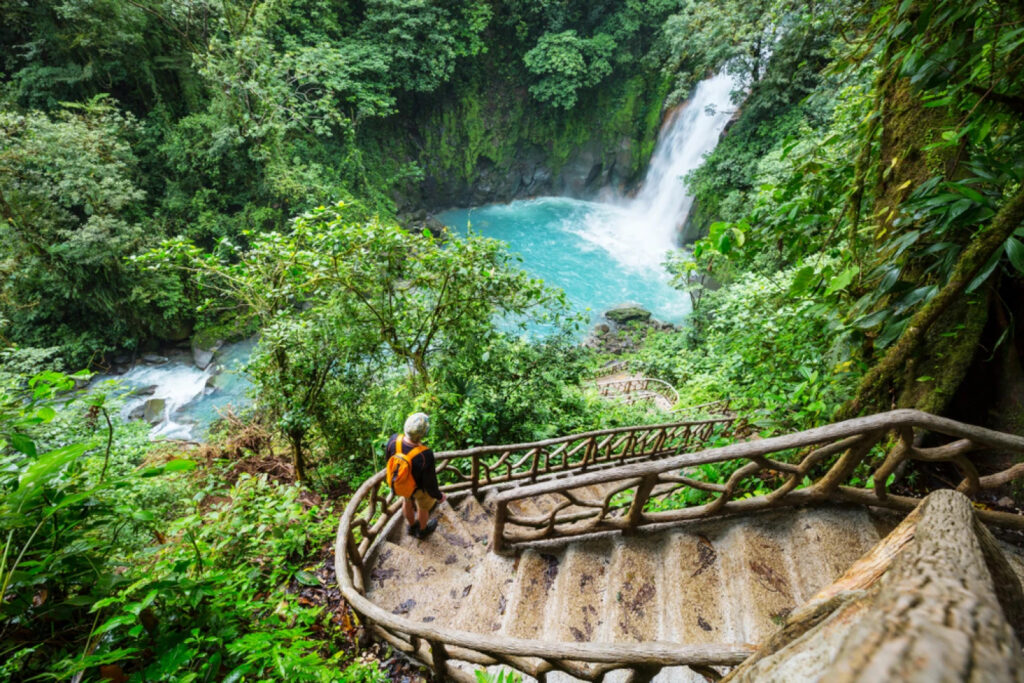
7. Dive into waterfalls and rivers
Beyond its long ocean-fronting coastlines, Costa Rica is also home to a number of rivers and streams. While these attract kayakers and rafters from all over the world for high stakes action, it’s definitely part of the local Tico culture to make for a refreshing swim in a waterfall or stream. Go on a hike on the Osa Peninsula, and there visitors can find many hidden waterfalls and pools to jump into and explore.
La Fortuna is home to numerous rivers and waterfalls, where families can try tubing (also in Manuel Antonio National Park) and the adventure sport of canyoning (an activity that consists of rappelling down cascading waterfalls and unique rock formations). For rafting diehards, the best rafting spot is the Pacuare River. At its peak from mid-May through March, it’s the country’s longest river, best explored on a two-day trip, and easily accessible from San José.
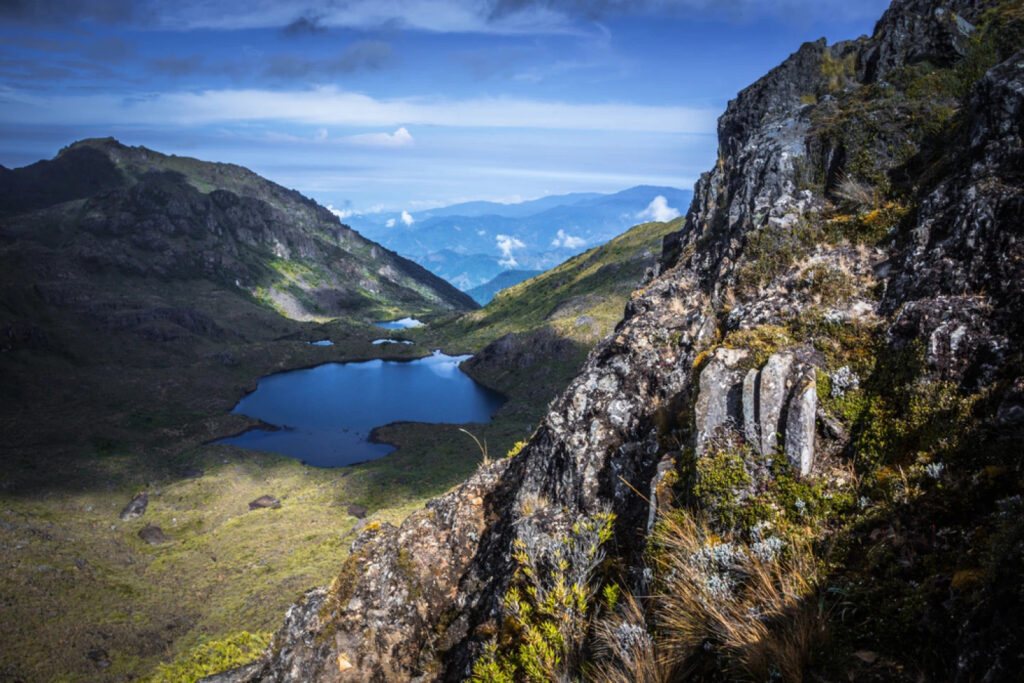
8. Climb a mountain
At 12,530 feet, Cerro Chirripó is the highest mountain in the country and a must-do adventure for those in the know. It isn’t a technical climb, but a 23-mile round-trip hike that gains over 8,600 feet of elevation and is typically doable in two days.
The climb offers the chance to experience different parts of the climate and ecosystem change on the way up. It’s no small affair with massive vegetation that shrinks with elevation, and over 400 species of birds and 260 species of amphibians and reptiles across the park. It’s challenging—especially climbing the Cuesta de los Arrepentidos (the hill of regrets). The trek requires a certain level of physical fitness, but the view—which goes as far as the Pacific and the Caribbean on a clear day—is worth it.
Source : AFAR

